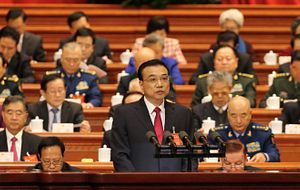Premier Li Keqiang’s government work report, the centerpiece of China’s “two sessions” of the National People’s Congress and Chinese People’s Political Consultative Congress, generated lots of headlines but not much new policy for 2017. That supports the view – previously floated by the government at the December 2016 Economic Work Conference – that the focus for 2017 is on keeping the economy stable and managing risks, rather than unleashing radical reforms.
In line with this, markets have been muted since Li’s March 5 speech, with the Shanghai index rising 0.07 percent by March 8, and major forecasters, such as Wang Tao at UBS, leaving their China GDP forecasts for 2017 unchanged. Top line numbers in the speech, such as the “6.5 percent or better if possible” forecast for GDP, 3 percent growth in the consumer price index (CPI), plus 12 percent growth in M2, a broad measure of money supply, give a basic outline for the year, but the following influencing trends for the economy give a more detailed outline for 2017.
Closer management of monetary policy: Building inflationary pressure and concerns about debt flows to overextended sectors, such as real estate, means the government will take a more measured approach to monetary policy in 2017. The official line is a “prudent and neutral” approach in 2017, in contrast to the expansionary attitude in 2016. That likely means closer control on liquidity flows and targeted policy moves, like its recent open market operations, because the government wants to ration credit to some sectors while channeling finance to other sectors to ensure growth. That said, the government’s 12 percent target for 2017 money supply growth is slightly higher than the 11.3 percent recorded in 2016, showing that, despite stronger controls, the government will grow liquidity faster than forecast GDP, suggesting that China will continue to have a highly-leveraged economy in 2017.
Squeeze on the real estate sector: Rapid credit and price growth in 2016 means policy controls and downward pressure on GDP through slower real estate investment in 2017. Tighter buy-side policies, such as stricter mortgage criteria and higher down payments, will squeeze demand in first- and second-tier cities that have seen fast price growth, such as Shenzhen and Nanjing, while policy will remain loose in third-and fourth-tier cities with inventory overhang. For developers, curbs on capital raising and bank financing will slow investment, and sales restrictions may spark capital stress and drive M&A and market consolidation.
Focus on fiscal policy: The government plans RMB 550 billion ($80 billion) in tax cuts and rebates to boost private sector investment, as well as $503 billion commitments to rail projects, $131 billion on water projects, and major outlays on roads and telecoms infrastructure. The huge numbers may push the government’s budget deficit over 3 percent, but more concerning is the increasing bond issuance by local governments, estimated by UBS’s Wang Tao at $115 billion for 2017. Together with the growth in the use of PPP financing, estimated at $579 billion in 2017 alone, this suggests that concerns about China’s debt-fueled economic model and the state of local government finances will persist in 2017.
Excess capacity removal: Capacity cutback targets of 50 million tonnes in the steel industry, as well as 150 million tonnes in the coal sector in 2017, if enacted, will no doubt be a blow to GDP numbers and employment in China’s rust-belt states, such as Heilongjiang, Hebei and Shanxi, but HSBC believes the moves will be a positive long-term move for the economy because they will drive debt restructuring and write-offs.
Of course, mention of reforms came up frequently both in Li’s speech and in official commentary on the sidelines of the meetings, but the Beijing meetings failed to produce a clear roadmap for what to expect by way of reform during the coming year, indicating that meaningful reform, or drastic changes to the way the economy operates, remains a long-term aspiration, rather than a concrete commitment to meaningful change.
As for near-term prospects economy, the slew of official data scheduled for next week will give a read on how the above driving factors have played out so far in 2017, and I’ll be highlighting the key trends in my next post.
































